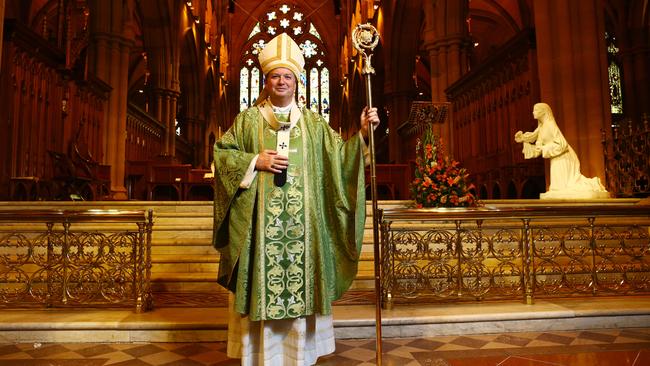False promise of indigenous ‘treaty’ could derail recognition

There are times in any great cause when its destiny just swirls in the wind. Depending on the next gust, it can float upward or fall to the ground like so much historical litter.
Constitutional recognition of indigenous people has come to this point. After years of talk and tears, it has never seemed more desperately vulnerable.
Ironically, its greatest threat comes from the Left. Moves by states such as Victoria and South Australia to develop “treaties” between Aboriginal “nations” threaten to bypass genuine recognition in a flash of showy, self-conscious, moral ostentation. These moves mean nothing. They will deliver nothing. In legal, constitutional and political terms, they are nothing.
But just as they appeal to their non-indigenous sponsors as grandiloquent gestures into empty space, they appeal to a sizeable portion of indigenous Australia, and for completely different and utterly comprehensible reasons.
To many indigenous people, the notion of a treaty is the ultimate panacea. With bitter memories of a legal and constitutional system that has failed them in so many ways, a treaty would stand above and outside that system. For them, a treaty would straddle, not be part of, Australia’s constitutional settlement.
As much is reflected in the use of the term nation. No longer could indigenous people be dismissed as an insignificant part of the wider Australian people. As nations, they could stand beside a coequal Australia, partners in dignity and sovereignty both. It is a deeply seductive proposition. And it is a fiction.
It certainly is true that states such as Victoria and South Australia can enter into agreements with groups of indigenous people. Those agreements can be given statutory force by acts of state parliaments, if this is desired. It even is the case that state legislation could refer to such agreements as treaties and their parties as nations. There is no constitutional prohibition against legislating untruth.
But no amount of wishful thinking will make these agreements treaties or their signatories nations, in law or reality, in the way many indigenous people desire. Nothing will produce the result that these agreements stand above our constitutional system, conferring on indigenous people that genuine quality of sovereignty, the unlimited capacity to enact one’s own future.
All this can be proved in two very simple ways. Forever after the making of these treaties, they will be able to be changed, amended or abolished by simple legislation of the state parliaments that created them. Nations may be abolished by the stroke of the pen. If an act of the South Australian parliament were inconsistent with solemn treaty provisions, then however trivial, that act would prevail
The situation is even more marked at commonwealth level. Not only could the Australian parliament legislate to abrogate treaty provisions or nation status but, to the extent that state-authorising legislation was inconsistent with commonwealth enactments, it would be unconstitutional.
These are treaties that do not bind, nations that in law will not exist and sovereignty that carries no authority.
There potentially is an even bleaker constitutional prospect. There is the possibility that the High Court, confronted by the language of treaties and nations, would view the entire scheme as inconsistent with the existence of the federal polity created by the Constitution. But this is unlikely. More probable would be that the court would disdain to deal with these arrangements as the legal charade they would be.
One response to all this would be to acknowledge the legalities but ask whether some good would not be done in any event. Would it really be so bad if the dignity of indigenous people received much-needed reinforcement? If services and support flowed under treaties, would this not be a good thing?
In truth, this “never mind the quality, feel the width” approach will not fly. These phony treaties go far beyond being harmless, Carlton-Balmain frippery. They will damage relations between indigenous and non-indigenous Australians for years to come, and derail the already straining engine of genuine recognition.
The first rider of this Apocalypse will be indigenous disappointment and betrayal — yet again. Doubtless, in the immediate afterglow of treaty-making, there will be a sense of pride, achievement and hope. Then reality will set in.
Indigenous groups will not become self-determining nations. Governments will interfere in their affairs whenever it is politically expedient to do so. Sovereignty will start as a trumpet and end as a reedy flute.
Indeed, this conferred sovereignty will have much in common with another, much older symbol of indigenous degradation. Like the old brass “king plates” that were strung around the necks of carefully selected Aboriginal “chiefs” in token of their non-existent authority, our Aboriginal people will grimly drag behind them the burden of yet another worthless gesture by white Australia.
The second disaster will be the reaction in many parts of non-indigenous Australia.
Words such as treaty, nation and sovereignty do not only have meaning to our first inhabitants. They have powerful associations in the ears of later arrivals.
Some non-indigenous Australians have a nuanced ear in this context. They understand that when many of their indigenous brothers and sisters say “treaty”, they mean “solemn agreement”. When they say “sovereignty”, they mean a reasonable degree of control over one’s own special affairs.
But many other Australians have neither the semantic delicacy, nor the desire to draw such subtle distinctions. Worse, they are reinforced in this view by the stern utterances of indigenous radicals such as Michael Mansell and Gary Foley, who when they say treaty mean treaty, and when they say sovereignty mean functional separation.
Enter Pauline Hanson, trailing anti-recognition activists like Keith Windschuttle and Gary Johns. To them, the treaty-nation movement will be a political battering ram dropped from heaven above. They will use it to convince Australians that their nation is on the verge of disintegration by special entitlement.
More effective voices, such as Andrew Bolt, will join in but adopt an additional tack. See, he will say, where all those seemingly moderate proposals from Noel Pearson and that idiot Greg Craven lead? Recognition ends not in some solemn declaration and an ongoing project of national re-engagement but in constitutional dissolution.
If all paved roads lead to Rome, the cry will go, the stony track of recognition leads to ruin.
There is no reason to suppose that such arguments will not bite with the Australian people. As they have shown in multiple referendums, they are deeply constitutionally conservative, never prepared to risk even the remotest hint of catastrophe.
So once recognition becomes firmly linked in the public mind with such radical proposals as treaties, nationhood and sovereignty, it will be irrevocably doomed.
This underlines one of the harsh realities of the debate over recognition. It is often said that there can be no point in proposing a form of recognition that is not supported by indigenous people themselves.
This is true, yet indigenous support is a necessary but not sufficient condition. It is equally true that there is no future in proposing a form of recognition that is acceptable to indigenous people but will be rejected by the vast majority of Australians.
What this means is that if the only form of recognition supported by indigenous people consists in formal treaties between recognised nations, we are going to have to forget the whole project. It would be grotesque to proceed cheerfully down a road that can end only in bitter disappointment and recrimination.
This is where the real damage is being done by the treaty push. What it threatens to do is to sideline vastly more effective, more achievable proposals on the basis that they are just not good enough. Only a treaty will do.
We should be quite clear here that state “treaties” are merely conscious precursors to a national equivalent. Once the state processes are up, there will be an insistent call for an Australia-wide treaty with constituent nations. Lesser proposals will be dismissed as Uncle Tom constitutionalism.
Yet because of the iron laws of constitutional referendums in Australia — big proposals fail, bigger proposals are eviscerated — this movement will end in crushing defeat. Indigenous recognition will have reached irresoluble stalemate.
There are tragic echoes here of the failure of the proposal for an Australian republic at referendum in 1999.
Swarms of left-leaning direct electionists, such as that declared political pest Phil Cleary, urged the Australian people to vote down the “politicians’ republic” on the basis that in a very short time they would be able to vote for a popularly elected president.
Seventeen years later, the Queen retains the throne, with a veritable queue of heirs. In 2033, Charles III may well be reigning over an Australia as far as ever from indigenous recognition.
Then there is the final, enervating blow of treaty-ism.
In recent years there has been an emerging view between many indigenous and non-indigenous Australians that true recognition and reconciliation should not involve ever-increasing degrees of separation: a sort of truculent national divorce, where indigenous people became progressively more indigenous and their co-citizens looked away politely.
On the contrary, the optimal position is where indigenous and non-indigenous people come closer and closer together until, while retaining their own cultures and histories, they also share a genuine merged and deeply treasured element of identity.
The most obvious point at which we will know this has been achieved is when Australians of non-indigenous descent can be as personally proud of the millennia of indigenous occupation, its culture and heroic survival as they are of the Eureka Stockade, Gallipoli and the building of modern Australia.
And where indigenous Australians can fully share in the pride in all those things, secure in the knowledge that this pride and sympathy is deeply reciprocated towards all their own triumphs, tragedies and achievements.
It is towards this mutuality of cultural respect, and even love, that we must be moving in political, legal and constitutional terms. Yet where would the treaty movement land us?
The whole point of a treaty is that it is intrinsically a proclamation of separateness. We haggle, negotiate and — with luck — agree, but the point is, we stand apart. We are parties, not collaborators.
This is the fundamental psychology of the treaty. It halts the process under which indigenous and non-Australians come together and bids them stand apart in different nations, tenuously linked by some written words that never will or can be honoured in the sense that was promised.
Never has a gaudier handful of beads or a blunter axe head been on offer.
This is a turning point in the debate over recognition, especially for indigenous people. As a nation, we can be dazzled by a tinselly distraction, and amble off into a dreamland that will progressively turn into a desert.
Or we can face the fact recognition is a great task, and that great tasks demand great work. There is no simple prescription for a solution that will bring Australia’s first and later peoples together in a meaningfully renewed union.
That work will require careful, cautious constitutional amendment. It will demand a real declaration of recognition, not a document that pretends to be a treaty but one that acknowledges openly and with dignity what it is: a detailed promise of fair treatment and real dialogue going forward, but within, not outside, our political and constitutional system.
We need an indigenous body that can constructively scrutinise, not veto, government action against that declaration: not pretend national structures without suasion or security.
And we need this whole apparatus, so deeply consistent with our overarching constitutional system, to deliver real and ongoing change, together with an irrefutable sense of genuine national inclusion in our indigenous people.
This is a project worthy of us all.
Greg Craven is vice-chancellor of the Australian Catholic University.



To join the conversation, please log in. Don't have an account? Register
Join the conversation, you are commenting as Logout